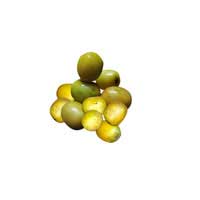 Full List of Fruits
Full List of Fruits  Lapsi fruit
Lapsi fruitLapsi fruit
Scientific name - Choerospondias axillaris
Having its roots from the family of Anacardiaceae, Choerospondias axillaris also known as Lapsi is known by different names like Lepchipoma in Assamese and Amrda in Bengal. From India to China to Japan, it is native to much of Asia. This deciduous tree grows up to 20 meters tall, and its compound leaves are 40 cm (16 in) long and separated into 3 to 6 fragile egg-shaped leaflets each up to 12 cm × 4.5 cm (4.7 in × 1.8 in). Besides the fruit, the tree is known for its valuable wood and hard seeds used for medicinal values and they are also burned for fuel.
Sharing the same features of a plum, these oval-shaped fruits are greenish-yellow when ripe. With high vitamin C content, even at full ripe stage they are extremely sour, however it also contains a pleasant tart flavor, where some people eat it fresh, while others use in the making of dried fruit nuggets that's both sweet and salt. Pulp separation from the seeds is difficult to segregate, but by cooking it becomes very easy. With a large brown seed, the fruits have a hard rubbery skin and pale yellow flesh, which is firmly attached to the seed.
![]() Nutritional Value of Lapsi fruit
Nutritional Value of Lapsi fruit
| Vitamins | value |
| Calories | 380 |
| Moisture | 84.8 (83.6-86.0) |
| Ash | 4.6(3.9-4.7) |
| Fat | 5.9(5.2-6.6) |
| Protein | 14.5(14.0-15.1) |
| Carbohydrate | 75.0(75.0-75.0) |
| Na | 5.0(5.0-5.0) |
| K | 639.3(577.6-659.9) |
| Ca | 202.1(201.9-202.4) |
The fruit, when is at its sour green stage is used as a tamarind-like flavoring. They are also used for making ice creams, sweets, jellies and pickles. They are 3cm long and 2cm wide. Although, the skin of the fruit is very thin, it contains an acidic succulent pulp that's rich in amino acids and vitamin C. Apart from the fruit, there are several other uses as well. The leathery bark is used in rope making. With a marked silver particle, the grayish-white wood is used as light construction timber for making tea chests and general furniture items. The wood is also used for fuel and the seed shells make a great item as a fuel in brick kilns.
Carbohydrate profile of the fruit will reveal that it has low simple carbs and high complex carbs; totally it contains 59.38g of carbs. Seeing that carbs are a primary source of energy, prescribed level of use is important. It has average protein content present in it. Given that, it contains high fat, people who are on diet should avoid consuming it. If you are looking for a low-sodium fruit, then Lapsi is a suitable and healthy low-sodium diet for you.


















